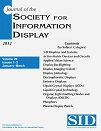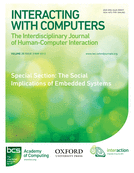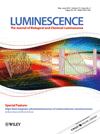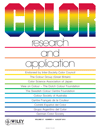
Journal of the Society for Information Display
Scope & Guideline
Transforming Knowledge into Display Solutions
Introduction
Aims and Scopes
- Display Technology Innovation:
The journal aims to explore cutting-edge innovations in display technologies including OLEDs, micro-LEDs, quantum dots, and other emerging materials that enhance display performance. - Human-Computer Interaction and User Experience:
Research in this area investigates how users interact with displays, focusing on visual comfort, fatigue, and perceptual factors that affect user experience in various display contexts. - Optical Engineering and Imaging Systems:
The journal covers advancements in optical engineering techniques that improve image quality, such as rendering methods, optical coatings, and holographic technologies. - Flexible and Wearable Display Technologies:
Research on flexible, stretchable, and wearable displays is a prominent focus, addressing the challenges and solutions for integrating display technologies into everyday applications. - Augmented and Virtual Reality Displays:
The journal emphasizes studies related to display technologies for AR and VR applications, including user interaction, depth perception, and immersive experience enhancements. - Manufacturing and Fabrication Techniques:
Insights into the manufacturing processes and technologies for display components, including inkjet printing, photolithography, and novel material synthesis, are a significant aspect of the journal.
Trending and Emerging
- Integration of AI in Display Technologies:
There is a growing trend towards incorporating artificial intelligence and machine learning techniques in display technologies, particularly for enhancing image processing, user interaction, and adaptive display systems. - Sustainability and Eco-Friendly Materials:
Recent publications show an increasing focus on sustainable practices in display technology, including the development of eco-friendly materials and energy-efficient manufacturing processes. - Enhanced Immersive Experiences:
Research is trending towards improving immersive experiences in AR and VR, with a focus on depth perception, realistic rendering, and user comfort, reflecting the industry's shift towards more engaging user interfaces. - Wearable Display Innovations:
The exploration of wearable displays is gaining momentum, with studies addressing challenges related to comfort, efficiency, and integration into everyday life, which are critical for future consumer adoption. - Advanced Manufacturing Techniques:
Emerging techniques such as inkjet printing and laser patterning for display fabrication are trending, highlighting the industry's push for more efficient and flexible production methods.
Declining or Waning
- Traditional LCD Technologies:
Research focused on conventional LCD technologies is gradually decreasing as newer technologies such as OLED and micro-LED gain prominence, reflecting a shift towards more advanced display solutions. - Basic Theoretical Studies:
There appears to be a waning interest in purely theoretical explorations of display technologies without practical applications, as researchers increasingly focus on applied studies that directly impact industry. - Static Display Applications:
The emphasis on static display applications is declining, with more research pivoting towards dynamic, interactive, and immersive display technologies tailored for modern consumer needs.
Similar Journals

INTERACTING WITH COMPUTERS
Fostering Dialogue in the Evolving Tech LandscapeINTERACTING WITH COMPUTERS is a renowned journal published by Oxford University Press, focusing on the interdisciplinary field of Human-Computer Interaction, as well as aspects of Library and Information Sciences and Software. With a rich history of publication since 1989, this journal has established itself as a significant platform for scholars to disseminate cutting-edge research and innovative methodologies that enhance our understanding of how humans engage with technology. Despite being classified in the Q3 and Q2 quartiles across various categories, its 2023 Scopus rankings highlight its relevance, positioning it within the 69th percentile for Library and Information Sciences. This makes it an essential resource for researchers, professionals, and students looking to stay informed about the latest advancements and discussions in this rapidly evolving domain. Though not currently open access, INTERACTING WITH COMPUTERS offers substantial insights that are crucial for driving forward the conversation in Human-Computer Interaction, ensuring its relevance in both academic and applied contexts.

Journal of Advances in Information Technology
Exploring the Frontiers of AI and ComputingJournal of Advances in Information Technology, published by ENGINEERING & TECHNOLOGY PUBLISHING, is an essential platform for researchers, professionals, and students invested in the dynamic fields of information technology, artificial intelligence, and computer science. With its ISNN of 1798-2340, this journal provides a rigorous peer-reviewed environment that supports the dissemination of innovative research findings, methodologies, and case studies. Since its inception in 2019, it has made notable strides, as reflected in its Q3 quartile rankings across various categories, including Artificial Intelligence and Software, and maintains respectable Scopus rankings, further solidifying its position as a key player in the academic community. Featuring a diverse range of topics within its scope, the journal encourages open access to knowledge while serving as a beacon for those seeking to expand their understanding of current trends and technologies shaping the future. Join us in advancing the field with impactful research that is both relevant and cutting-edge.

LUMINESCENCE
Empowering Researchers to Illuminate New FrontiersLUMINESCENCE is a premier international journal published by WILEY, dedicated to advancing the field of luminescence and its applications across various scientific disciplines. With an ISSN of 1522-7235 and an E-ISSN of 1522-7243, this journal plays a pivotal role in disseminating high-quality research from 1997 to 2024. Positioned in the <> Q3 quartile within Biophysics and Q2 in Chemistry (miscellaneous), LUMINESCENCE ranks #37 out of 111 in its chemistry category and #57 out of 152 in biophysics, reflecting its significant impact in these domains. The journal facilitates open access, enabling wide visibility and engagement with groundbreaking research findings. Aimed at researchers, professionals, and students alike, LUMINESCENCE serves as a vital platform for sharing innovative studies and fostering collaboration in luminescence phenomena, thereby enhancing our understanding and utilization of this critical aspect of modern science.

COLOR RESEARCH AND APPLICATION
Unveiling the Science Behind Color and Its Impact.COLOR RESEARCH AND APPLICATION is an esteemed journal dedicated to the exploration of color science, including its applications in various fields such as chemistry, human factors, and ergonomics. Published by WILEY, this journal has been a vital resource for both researchers and professionals since its inception in 1976, with a commitment to disseminating cutting-edge research and innovative methodologies. With an impact factor that reflects its significance in the academic community, COLOR RESEARCH AND APPLICATION ranks in the Q2 quartile across multiple categories, including Chemical Engineering, General Chemistry, and Human Factors and Ergonomics, illustrating its interdisciplinary importance. As a premier publication, it serves to bridge the gap between theoretical developments and practical applications of color science, thereby catering to a diverse readership that includes students, industry practitioners, and esteemed researchers. The journal offers a wealth of articles that not only enrich the understanding of color but also contribute to advancements in technology and human experience, ensuring its pivotal role in shaping future developments in the field.

Journal on Multimodal User Interfaces
Driving Collaboration in Multimodal Interface ResearchJournal on Multimodal User Interfaces, published by Springer, serves as a vital platform for scholarly exchange in the rapidly evolving fields of Human-Computer Interaction and Signal Processing. Established in 2008 and continuing through 2024, this journal maintains a high profile in academia, currently ranking in the Q2 category for both fields, indicating its significant contribution to ongoing research and practical applications. With its Scopus rankings placing it at #34 in Signal Processing and #49 in Human-Computer Interaction, it is recognized for publishing high-quality, impactful research. Although it is not an Open Access journal, the Journal on Multimodal User Interfaces remains accessible through institutional subscriptions. Researchers, professionals, and students will find the journal an essential resource for advancing knowledge and fostering collaboration in multimodal interaction technologies, which are crucial for enhancing user experience and developing intelligent systems.

Chinese Journal of Liquid Crystals and Displays
Exploring Innovations in Liquid Crystal TechnologyThe Chinese Journal of Liquid Crystals and Displays, published by SCIENCE PRESS, serves as a vital platform for researchers and professionals in the fields of electronic, optical, and magnetic materials as well as instrumentation and signal processing. With an ISSN of 1007-2780 and an E-ISSN of 2097-3217, this journal offers a unique perspective on advancements in liquid crystal technology and display innovations, reflecting the dynamic growth of this area of study since its convergence in 2015 through to 2024. Despite currently occupying a Q4 quartile ranking in multiple categories, researchers and industry practitioners will benefit from its publication of cutting-edge research, comprehensive reviews, and insightful discussions. Although not an open-access journal, this publication remains essential for those seeking to expand their knowledge and stay abreast of emerging trends in liquid crystals and display technologies, particularly from a Chinese perspective.

INTERNATIONAL JOURNAL OF HUMAN-COMPUTER INTERACTION
Transforming User Experiences Through ResearchINTERNATIONAL JOURNAL OF HUMAN-COMPUTER INTERACTION, published by Taylor & Francis Inc, stands at the forefront of research within the interdisciplinary fields of human-computer interaction, human factors, and ergonomics. Since its establishment, the journal has consistently contributed to advancing the understanding of the interactions between people and computers, making it a vital resource for researchers, professionals, and students alike. With an impressive impact factor reflecting its high citation rate, this journal is recognized as a Q1 publication in both Computer Science Applications and Human Factors and Ergonomics categories for 2023, showcasing its stature within the academic community. Additionally, it boasts a commendable ranking within the top percentiles in key areas on Scopus, ensuring that the research published here reaches broad scholarly audiences. Available in traditional subscription format, the journal covers seminal studies from 1989 to 2024, reflecting ongoing innovation in technology and its applications in everyday life, and thus serves as an essential platform for pioneering research that shapes the future of user experience.

ACM Transactions on Applied Perception
Fostering Interdisciplinary Dialogue in Perception ScienceACM Transactions on Applied Perception is a leading journal published by the Association for Computing Machinery, focusing on the intersection of perception science and computational methods. With an ISSN of 1544-3558 and an E-ISSN of 1544-3965, this esteemed publication has been a vital resource for innovators and researchers since its establishment in 2004. It operates within the ambit of Computer Science and the realms of Experimental and Cognitive Psychology, boasting a commendable impact factor and category rankings, including Q2 in Computer Science (miscellaneous) and Q3 in both Experimental and Cognitive Psychology and Theoretical Computer Science. The journal's scope encompasses a plethora of studies aimed at understanding human perception through computational lenses, making it an essential platform for scholarly exchange. Although it does not currently offer an Open Access option, its extensive reach and rigorous peer-review process ensure high visibility and impact in the academic community. By fostering collaboration across disciplines, ACM Transactions on Applied Perception encourages advancements that bridge perceptual research with practical applications, making it invaluable for researchers, professionals, and students engaged in this dynamic field.

CCF Transactions on Pervasive Computing and Interaction
Transforming Ideas into Pervasive SolutionsCCF Transactions on Pervasive Computing and Interaction, published by SPRINGERNATURE, is a leading academic journal dedicated to advancing the field of pervasive computing and interaction. With an ISSN of 2524-521X and E-ISSN 2524-5228, this journal is well-regarded for its rigorous peer-reviewed research, featuring influential studies that explore the intersection of Artificial Intelligence, Computer Networks and Communications, Computer Science Applications, and Human-Computer Interaction. Recognized in the 2023 journal rankings, it holds a prestigious Q2 quartile classification across these domains, reflecting its impact and relevance in the academic community. Researchers and practitioners can greatly benefit from its contributions, showcasing innovative approaches and technologies that shape the future of interactive computing. Although currently not following an open-access model, the journal underscores its commitment to high-quality research dissemination, making it a vital resource for those interested in the evolving landscape of pervasive technologies and user-centric designs. For more information on submissions and access options, please refer to the official website.

MUSEOLOGIA SCIENTIFICA
Advancing the Frontiers of MuseologyMUSEOLOGIA SCIENTIFICA is a distinguished journal dedicated to the study and advancement of museology, published by the ASSOCIAZIONE NAZIONALE MUSEI SCIENTIFICI in Italy. Focusing on a wide array of topics within the realm of science museums, the journal offers rich insights and research findings that shape the future of museum practices and education. Although currently not an open-access publication, MUSEOLOGIA SCIENTIFICA provides a vital platform for scholars, practitioners, and students interested in the preservation, curation, and display of scientific artifacts. By contributing to the discourse on innovative museum practices, the journal plays a crucial role in enhancing the professional standards within the field while promoting collaboration among museums worldwide. We invite researchers and practitioners alike to explore its valuable content, aimed at broadening understanding and knowledge in the ever-evolving landscape of museology.